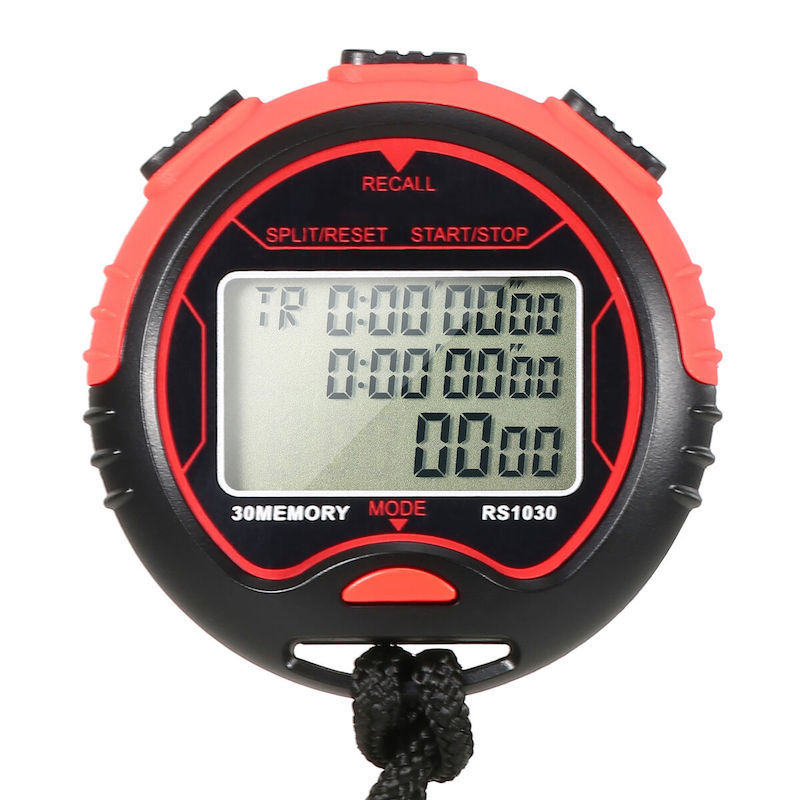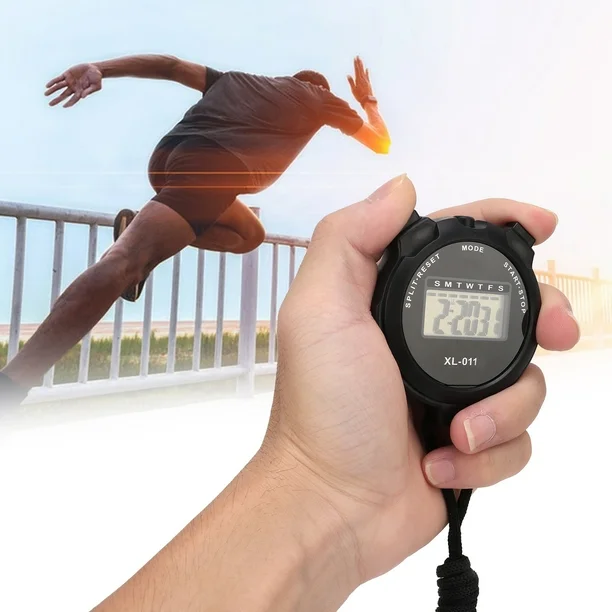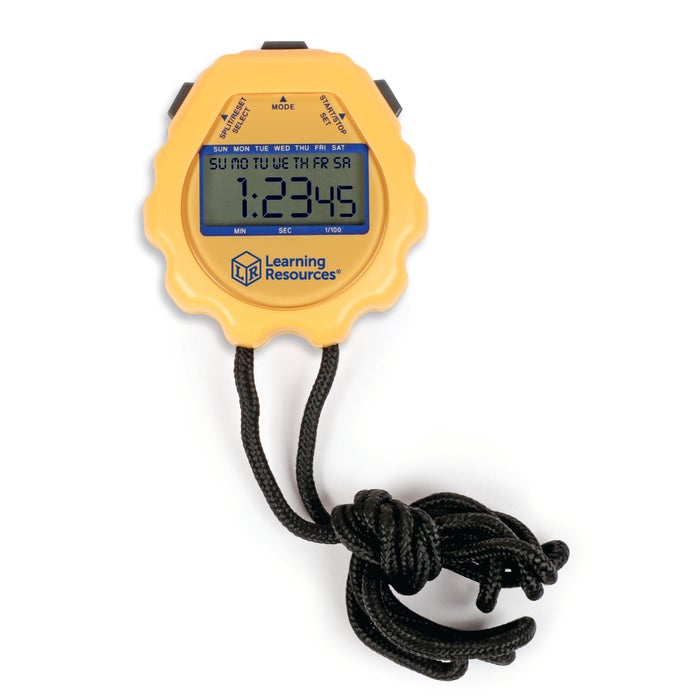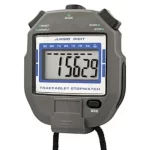The Basics of a Stopwatch
Understanding how to read a stop watch starts with knowing the basics. A stopwatch is a tool designed to measure the amount of time that elapses between its start and when it is stopped. It is commonly used in sports, cooking, and various other activities where precise timing is crucial.
Different Types of Stopwatches
There are several types of stopwatches ranging from classic mechanical models to advanced digital ones. Analog stopwatches have a main dial with moving hands, just like a standard clock. Digital stopwatches, on the other hand, display the time electronically with numbers. Some stopwatches come with extra features like memory recall, lap timers, and waterproof exteriors for outdoor use.
When choosing a stopwatch, consider what you need it for. Simple activities may only require a basic model, whereas professional use might necessitate a stopwatch with more advanced capabilities.
Stopwatch Display Icons Explained
Digital stopwatches often come with various icons on their display. These can include symbols indicating battery life, an alarm setting, and sometimes even connectivity to other devices, such as heart rate monitors. Commonly used icons are the ‘start/pause’ symbol, which is typically a triangle pointing to the right, and the ‘stop’ icon, which usually looks like a square.
On many stopwatches, you’ll also find a lap counter icon, resembling a flag, which is used to record individual laps or split times. Understanding these icons is key to effectively operating the stopwatch and accurately capturing the time for your activities.
Preparing to Use a Stopwatch
Before you start your timing adventure, setting up your stopwatch correctly is crucial for accurate measurements.
Initial Setup
Begin by ensuring your stopwatch’s battery is fully charged or, if it uses one, fresh. For digital models, set the current date and time. This helps in organizing and tracking past events if your stopwatch has memory functions. Some stopwatches also require you to select the unit of measurement (seconds, minutes, hours), so be sure to adjust this according to your needs.
Basic Functions and Buttons
Familiarize yourself with the main buttons on your stopwatch. A typical stopwatch will have a start/stop button, a lap/reset button, and perhaps a mode button for accessing different features. The start/stop button begins and pauses timing, while the lap/reset button can mark split times or reset the timer to zero. Using the mode button, you can switch between timing functions or set up alarms and countdowns. Consistent practice with these buttons will lead to seamless operation during your timed activities.
Starting and Stopping the Stopwatch
To effectively use a stopwatch, mastering the starting and stopping process is essential. This is important whether you are tracking time for athletic training, scientific experiments, or cooking.
How to Start Timing
Starting the timer on a stopwatch is straightforward. Press the ‘start’ button to begin timing. For digital stopwatches, this is often represented by the play icon, which looks like a rightward facing triangle. As soon as this button is pressed, time measurement commences. Ensure that you start the timer right at the beginning of the activity you’re timing to ensure accuracy.
Stopping and Pausing the Timer
To halt the time measurement, the ‘stop’ button, usually depicted as a square, must be pressed. If you need to pause the timer to resume it after a short break, press the same button used to start the timer. This will freeze the time on the display. To continue, simply press the ‘start’ button again. This pause feature is helpful when you need a momentary stop without resetting the entire timing sequence.
Timing is a critical aspect of many activities, and knowing how to properly start and stop a stopwatch is the foundation of precise timekeeping. By following these simple steps, you can ensure your timed activities are measured accurately.
Recording Split Times and Laps
To further your expertise on how to read a stop watch, learning about split times and laps is vital. Split times help you understand the duration of segments within your overall timed activity, while laps are used to mark individual periods of time in repetitive activities like running on a track. Let’s delve into what these are and how you can record them on your stopwatch.
What Are Split Times?
Split times, also known as splits, are the individual time intervals recorded from the start of an event up to a certain point. They allow you to track the time taken for each section of a race or any segmented event. This is especially useful in training and assessing the consistency of an athlete’s performance. Knowing split times can help refine pacing strategies and improve overall times.
How to Record Laps on a Stopwatch
To record a lap on a stopwatch, you must use the lap function. During a timed event, when you reach the end of a lap or a segment, press the lap button. This will usually be labeled ‘LAP’ or depicted with a flag icon. When you press this button, the stopwatch preserves the current time but continues to run for the next lap. At the end of your event, you can review all the lap times to analyze performance across different stages. With practice, you’ll master lap recording and gain deeper insights into your timed activities.

Reading the Stopwatch Display
Navigating through the display is a cornerstone in learning how to read a stop watch. The stopwatch display may seem daunting at first, but with some guidance, it becomes intuitive.
Interpreting the Numbers
When you glance at your stopwatch, numbers are what you primarily see. For digital stopwatches, these numbers represent hours, minutes, seconds, and sometimes even microseconds. The first set of numbers from the left typically indicates hours or minutes, depending on the stopwatch’s maximum time capacity. The subsequent sets show minutes and seconds, respectively. If you see numbers following a decimal point or colon, these often signify fractions of a second, vital for precision timing. Recognizing which number corresponds to which unit of time is crucial for proper interpretation of results.
Understanding the Timer Increments
Stopwatches function through increments, the smallest unit of time they can measure. Most modern digital stopwatches measure time in increments of one-hundredth of a second, represented by the numbers to the right of the decimal point or second colon. Higher-end models may measure even smaller increments, offering greater precision. For instance, a time displayed as 01:30.59 translates to one minute, thirty seconds, and fifty-nine hundredths of a second. Understanding these increments allows for precise time tracking and assessment, which is especially important in activities where every hundredth of a second counts.
Advanced Stopwatch Features
As you become more familiar with how to read a stop watch, exploring its advanced features can enhance your timing activities. High-quality stopwatches offer a range of functions beyond mere start-stop capabilities that appeal to professional users or those requiring more sophistication in their timing tasks.
Using Countdown Timers
Many digital stopwatches include countdown timers, a useful feature for backward timing. To set it up, you input the time you want to count down from, and the stopwatch will tick away until it reaches zero. It’s particularly handy for timed tasks, such as cooking, where you need an alert at the end of the time period.
Press the ‘mode’ button to navigate to the countdown function, then use the ‘start’ button to commence the countdown. The stopwatch will beep or otherwise signal when the countdown has completed.
Alarms and Other Additional Functions
In addition to countdowns, contemporary stopwatches often boast alarm settings to remind you of important times. They can serve as a wake-up call, remember event start times, or as a reminder for specific intervals during a time-sensitive task. Furthermore, some models might offer connectivity options, enabling synchronization with other devices, or feature calendar functions to keep track of dates.
To use the alarm, you typically enter the alarm mode and set the desired alert time. Your stopwatch might also have the ability to set multiple alarms or recurring alerts, offering more complex time management solutions.
These advanced features of a stopwatch extend its utility beyond simple tracking, making it an indispensable tool for optimizing organization and time management in various scenarios. By incorporating countdown timers, alarms, and other additional functions, you can utilize your stopwatch to its full potential.
Tips and Tricks for Stopwatch Use
To get the most out of your stopwatch, apply these tips and tricks. They will help improve your timing skills and accuracy.
Maximizing Accuracy
Accuracy is vital when using a stopwatch. Here are some ways to achieve it:
- Start Precisely: Press the start button at the exact moment your event begins. Timing that is even a fraction off can lead to inaccurate results.
- Avoid Distractions: Focus on the task at hand. Distractions can cause delays in stopping or starting the timer.
- Use the Neck Strap: If your stopwatch has a neck strap, use it. This frees up your hands and makes it easier to hit the button instantly.
- Calibrate If Needed: For analog stopwatches, ensure calibration for accurate measurements. Check manufacturer guidelines for instructions.
By working on these aspects, your stopwatch readings will reflect more accurate timing.
Best Practices for Training and Competitions
When training or competing, stopwatch use is crucial. Follow these best practices:
- Preparation: Before starting, make sure the stopwatch is set correctly and you’re familiar with its functions.
- Consistent Button Pressing: Use a consistent pressure when pressing the buttons. It ensures uniformity in your timings.
- Regular Practice: The more you practice starting and stopping the stopwatch, the better you’ll get. Aim to reduce your reaction time.
- Review Past Timings: Look back at your records to understand your performance trends. It helps in planning improvements.
Adhering to these practices during training and competitions will help you utilize your stopwatch effectively for optimal performance.



